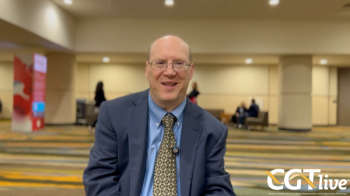
OpRegen Shows Durable Efficacy in Dry AMD Geographic Atrophy
The Doheny Image Reading and Research Lab is leading a sub study to analyze OCT images with their proprietary 3D-OCTOR software.
OpRegen (Lineage Cell Therapeutics) has continued to show safety and efficacy in patients with dry age-related macular degeneration (AMD) with geographic atrophy (GA), according to recent data from a phase 1/2a clinical trial (NCT02286089).1,2
The data were presented at the
“I am excited about several aspects of the optical coherence tomography (OCT), observations following our team’s detailed image review. First, there appear to be resolution of incomplete retinal pigment epithelium (RPE) and outer retinal atrophy (iRORA) in several patients. Additionally, there is evidence of resolution of areas with features of cRORA, or complete loss of the RPE and outer retinal tissue, in some eyes, which has not been previously reported. Finally, there are statistically significant improvement, or trends toward improvement, in the treated eyes versus the fellow eyes as compared from baseline to month 12 post-treatment in critical retinal tissue. I look forward to our group completing these analyses in the remaining patients as data become available,” Ip said in a statement.1
The study met its primary endpoint of safety and tolerability as no unexpected adverse events (AEs) or serious AEs occurred. Investigators did not observe any acute or delayed inflammation or any sustained increased intraocular pressure (IOP). All 24 patients reported at least 1 AE but 87% of these were mild (n = 333).2
READ MORE:
Over half (n = 7; 58%) of cohort 4 patients had a stable or increased score from baseline on Early Treatment Diabetic Retinopathy Study (EDTRS) scale for their treated eye. The same was true for only 4 patients when comparing their untreated eyes. Investigators also observed stabilized ellipsoid zone and RPE/drusen area in study eyes compared to reductions in these areas in control eyes (P <.05).1,2
Previously reported retinal restoration in 3 patients continued to persist. OpRegen RPE cells also demonstrated evidence of durable engraftment, persisting for over 5 years in the earliest treated patients.
“We are encouraged by this additional supporting evidence obtained from independent analyses of the OpRegen data in patients with atrophic AMD. When OpRegen is implanted in the transitional zones of the GA in patients with less advanced disease, reversing damage, or even simply arresting further progression for several years, has been shown to be possible. Restoration of retinal tissue is a compelling finding compared to conventional approaches which to date have only shown an unexceptional slowing of progression,” Brian M. Culley, chief executive officer, Lineage Cell Therapeutics, added to the statement.1
“In addition to being well tolerated to date, the durability of changes to areas of atrophy and improvements in visual acuity observed point to the urgency to further evaluate OpRegen in a larger, controlled trial. We currently are preparing for multiple engagements with FDA to discuss aspects of OpRegen’s designation, our manufacturing plans, and the design of a later-stage clinical trial. We expect the first of these engagements will begin in the fourth quarter of 2021 and continue in the first quarter of 2022,” Culley said.1
The Doheny Image Reading and Research Lab is leading a sub study that will further analyze the collected OCT images to assess the retinal layers and thickness with their proprietary 3D-OCTOR software. The lab has analyzed OCT images from the first 4 patients in cohort 4 to better visualize improvements in the visual structure. They are continuing to analyze images from the rest of cohort 4.
REFERENCES
1. OpRegen® clinical data presented at 125th Annual American Academy Of Ophthalmology meeting By Michael S. IP, MD. News release. Lineage Cell Therapeutics. November 15, 2021. https://investor.lineagecell.com/news-releases/news-release-details/opregenr-clinical-data-presented-125th-annual-american-academy
2. Ip MS, Nitala MG, Velaga S, Sadda V. Phase 1/2a clinical trial of subretinally transplanted allogeneic retinal pigmented epithelium cells in advanced dry age-related macular degeneration: Interim results and further insights from imaging analyses. Presented at: AAO 2021 meeting, November 12-15; New Orleans.
Newsletter
Stay at the forefront of cutting-edge science with CGT—your direct line to expert insights, breakthrough data, and real-time coverage of the latest advancements in cell and gene therapy.











































